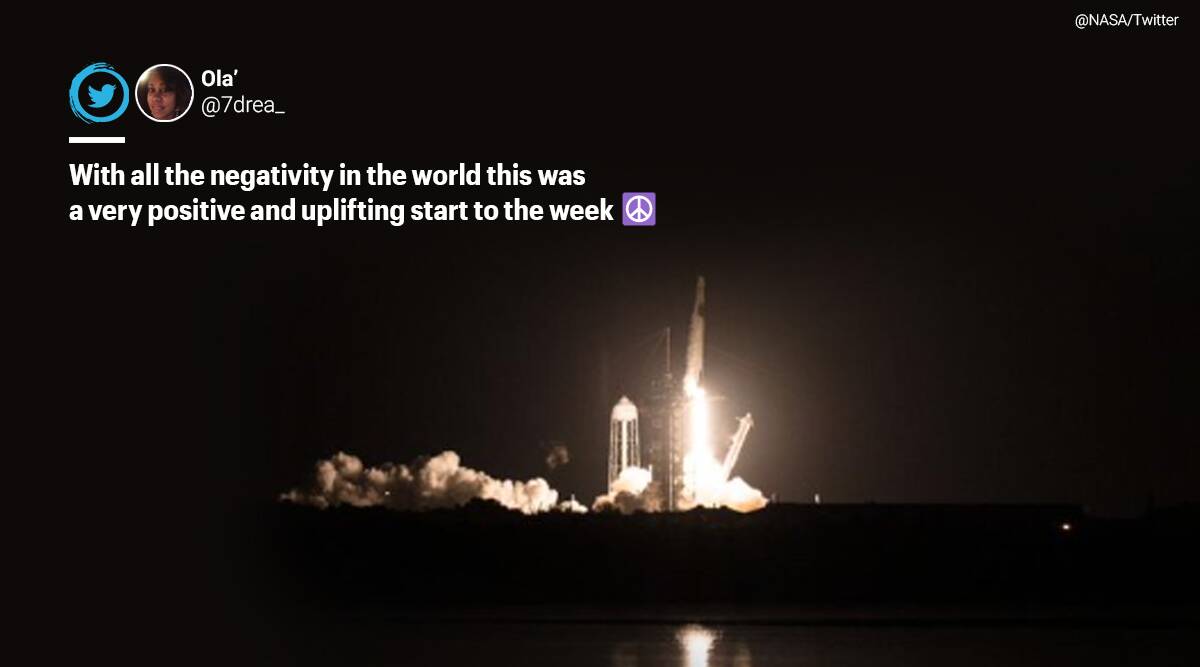TECHNOLOGY
People cheer on social media as SpaceX, NASA launch second crewed mission to space

 On Twitter, many celebrated the historic launch with congratulatory messages.
On Twitter, many celebrated the historic launch with congratulatory messages.
After SpaceX successfully launched its second crew of astronauts Sunday to the International Space Station inside the company’s Crew Dragon spacecraft had people cheering on social media.
The mission, called Crew-1, marks the first operational mission of the Crew Dragon, opening up the possibilities of the company regularly sending people to and from the International Space Station (ISS) for NASA.
“Resilience rises,” NASA wrote on Twitter, sharing the footage of the launch.
Resilience rises. 🚀
The Crew-1 mission has lifted off on a Falcon 9 rocket from @NASAKennedy at 7:27pm ET and is en route to the @Space_Station. #LaunchAmerica pic.twitter.com/5Q3uXSLvqt
— NASA (@NASA) November 16, 2020
The Falcon 9 rocket named ‘Resilience’ was launched from NASA’s Kennedy Space Center in Florida, and is expected to reach the space station late Monday and remain there until spring.
On Twitter, many celebrated the launch with congratulatory messages.
With all the negativity in the world this was a very positive and uplifting start to the week☮️
— Ola’ (@7drea_) November 16, 2020
Phenomenal
— jerrygu3 (@jerry_laundrie) November 16, 2020
Burn & separation still blow me away.
— Jan Lubin (@LubinJan) November 16, 2020
— Nancy_I_O_S 🪐 (@TSLATNA) November 16, 2020
Wowsers, amazing to watch! pic.twitter.com/Nwn3NPjRUj
— Karen Leach (@FunnyOldThing) November 16, 2020
Godspeed to this brave and remarkable crew and thanks to the thousands of people who helped make this possible. pic.twitter.com/qMnA4yusiE
— Susan Katz 📲📱 (@susankatz) November 16, 2020
Congrats! Another great moment for humanity! We are better together!!!! Looking forward to watching all 56 (!) scheduled launches in 2021 if at least because they’ll be moments of positivity! @SpaceX
— Sudha Jayaraman MD MSc FACS (@sudhapjay) November 16, 2020
We have lift off!!! ♥️🚀✨
— Margie Deese🔋🚀✨ (@MargieDeese) November 16, 2020
— venus 🧜♀️ (@venus47203379) November 16, 2020
Uplifting is the word! Crew-1 for all! 🥳🚀 pic.twitter.com/cq6QOQJ8Lq
— NASA (@NASA) November 16, 2020
Such an inspiration! Godspeed to the crew 🙌
— Ray’s the Roof (@rays_the_roof) November 16, 2020
Flying inside the capsule are three NASA astronauts — Mike Hopkins, Victor Glover, and Shannon Walker — as well as Soichi Noguchi, from the Japanese Aerospace Exploration Agency, or JAXA.
At the space station, the crew will join the members of Expedition 64, the space station crew currently in residence at the ISS. The astronauts are to conduct microgravity studies and deliver new science hardware and experiments that they will carry with them to space aboard the Crew Dragon spacecraft.
Earlier in May, NASA’s SpaceX Demo-2 test flight lifted off for the ISS, becoming the first crewed flight to launch from American soil since the conclusion of the space shuttle era in 2011.
Author:
The Indian Express is now on Telegram. Click here to join our channel (@indianexpress) and stay updated with the latest headlines
For all the latest Trending News, download Indian Express App.
© IE Online Media Services Pvt Ltd
